Comprehensive Analysis of Godiva UK: Strategic Recommendations Report
VerifiedAdded on 2020/06/06
|11
|2422
|1100
Report
AI Summary
This report provides a comprehensive analysis of Godiva UK, examining its business environment through a PESTLE analysis, which evaluates political, economic, social, technological, legal, and environmental factors impacting the company. It also applies Porter's Five Forces model to assess the competitive landscape, including supplier power, buyer power, the threat of new entrants, the threat of substitutes, and rivalry among existing competitors. Furthermore, the report utilizes Michael Porter's Value Chain Analysis to dissect Godiva's primary and support activities, identifying areas for value creation. Finally, it offers strategic recommendations for Godiva UK, suggesting approaches such as cost leadership, differentiation, and focus strategies to improve business performance, financial position, and overall efficiency.
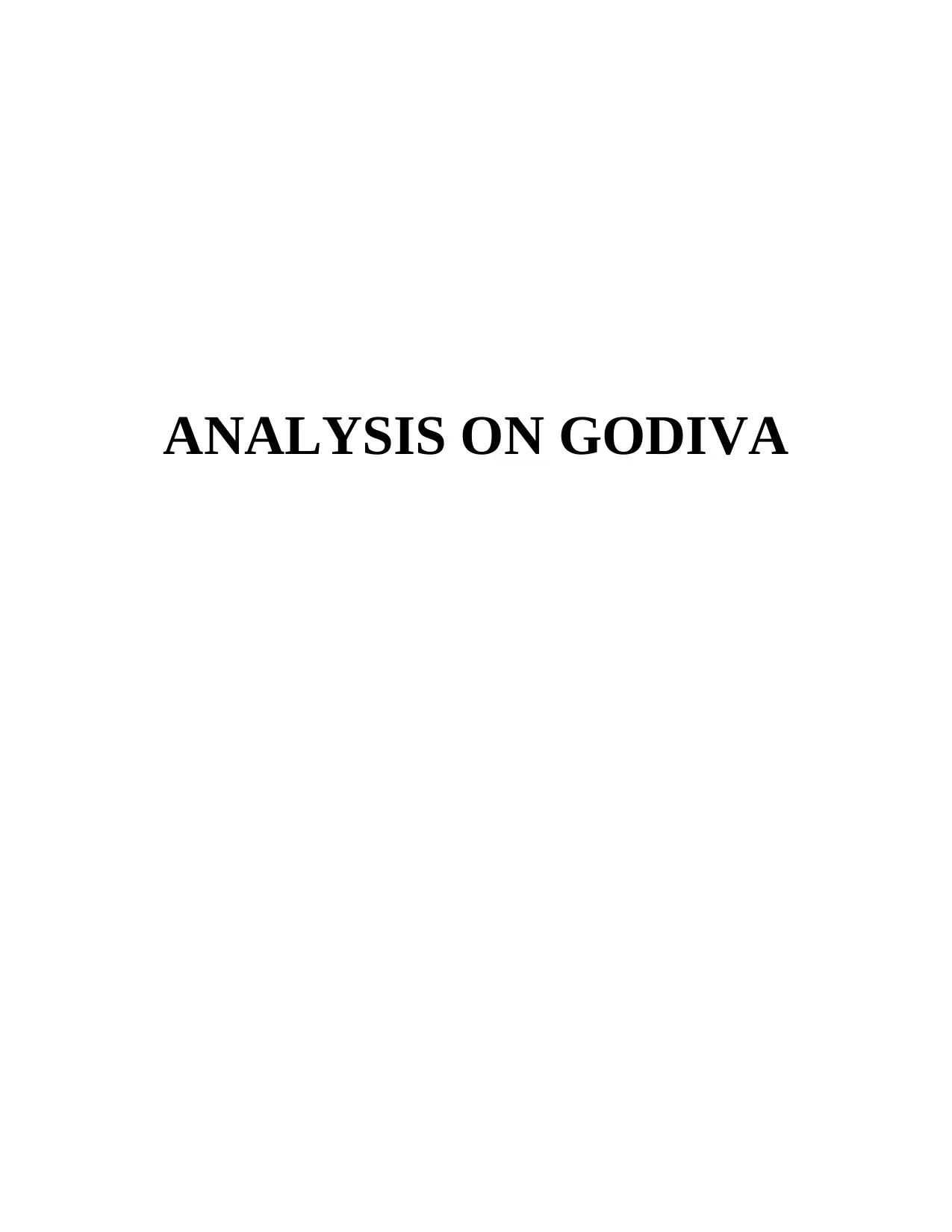
ANALYSIS ON GODIVA
Paraphrase This Document
Need a fresh take? Get an instant paraphrase of this document with our AI Paraphraser
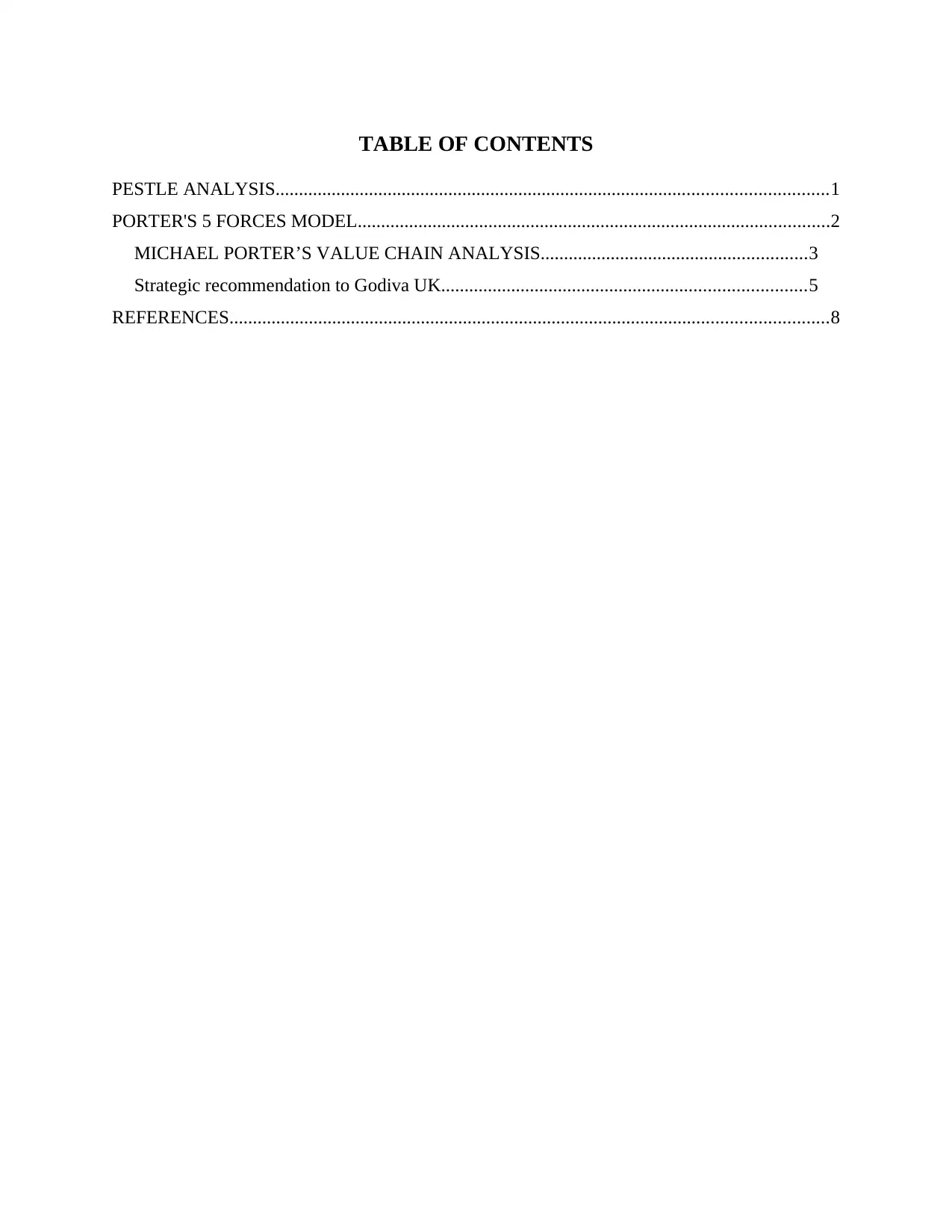
TABLE OF CONTENTS
PESTLE ANALYSIS......................................................................................................................1
PORTER'S 5 FORCES MODEL.....................................................................................................2
MICHAEL PORTER’S VALUE CHAIN ANALYSIS.........................................................3
Strategic recommendation to Godiva UK..............................................................................5
REFERENCES................................................................................................................................8
PESTLE ANALYSIS......................................................................................................................1
PORTER'S 5 FORCES MODEL.....................................................................................................2
MICHAEL PORTER’S VALUE CHAIN ANALYSIS.........................................................3
Strategic recommendation to Godiva UK..............................................................................5
REFERENCES................................................................................................................................8
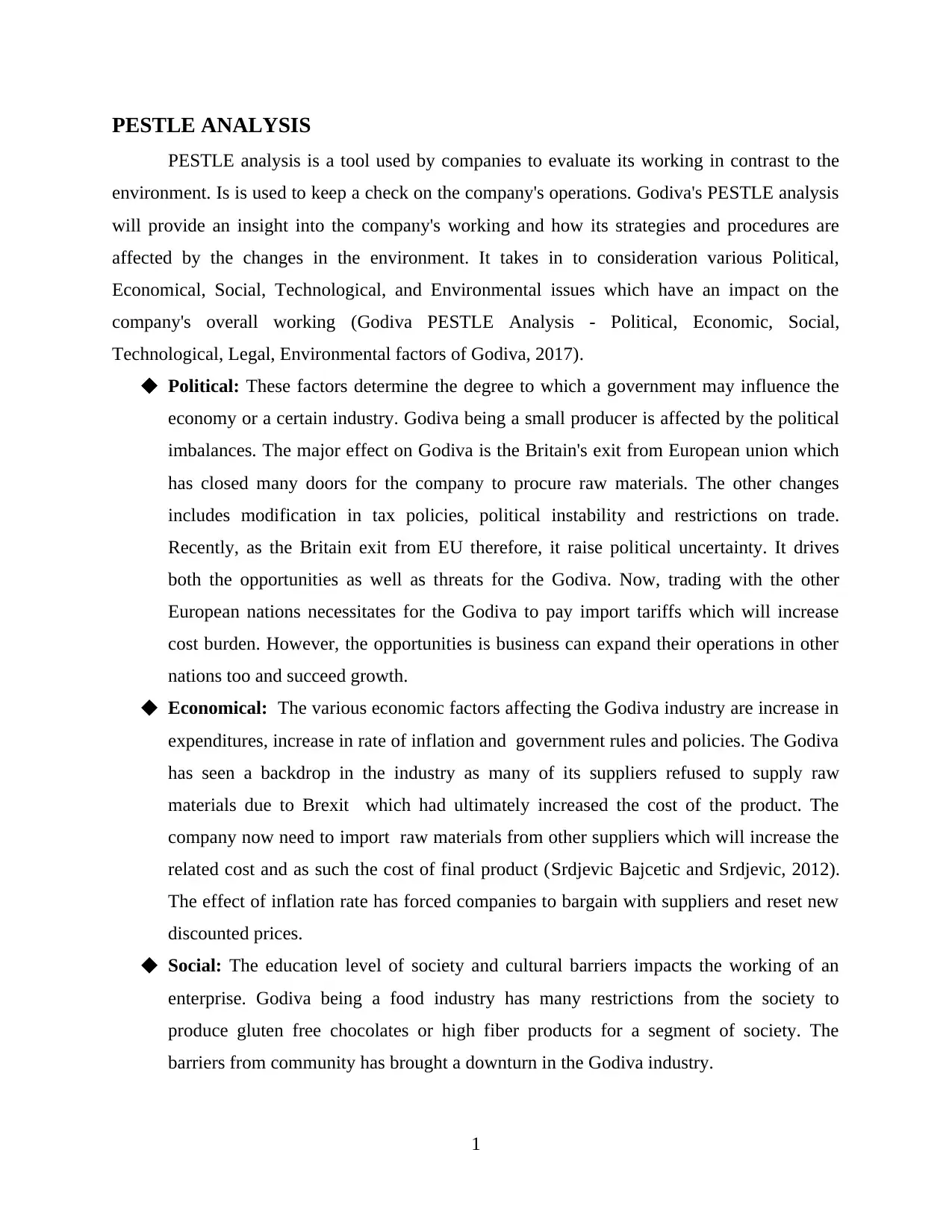
PESTLE ANALYSIS
PESTLE analysis is a tool used by companies to evaluate its working in contrast to the
environment. Is is used to keep a check on the company's operations. Godiva's PESTLE analysis
will provide an insight into the company's working and how its strategies and procedures are
affected by the changes in the environment. It takes in to consideration various Political,
Economical, Social, Technological, and Environmental issues which have an impact on the
company's overall working (Godiva PESTLE Analysis - Political, Economic, Social,
Technological, Legal, Environmental factors of Godiva, 2017).
Political: These factors determine the degree to which a government may influence the
economy or a certain industry. Godiva being a small producer is affected by the political
imbalances. The major effect on Godiva is the Britain's exit from European union which
has closed many doors for the company to procure raw materials. The other changes
includes modification in tax policies, political instability and restrictions on trade.
Recently, as the Britain exit from EU therefore, it raise political uncertainty. It drives
both the opportunities as well as threats for the Godiva. Now, trading with the other
European nations necessitates for the Godiva to pay import tariffs which will increase
cost burden. However, the opportunities is business can expand their operations in other
nations too and succeed growth.
Economical: The various economic factors affecting the Godiva industry are increase in
expenditures, increase in rate of inflation and government rules and policies. The Godiva
has seen a backdrop in the industry as many of its suppliers refused to supply raw
materials due to Brexit which had ultimately increased the cost of the product. The
company now need to import raw materials from other suppliers which will increase the
related cost and as such the cost of final product (Srdjevic Bajcetic and Srdjevic, 2012).
The effect of inflation rate has forced companies to bargain with suppliers and reset new
discounted prices.
Social: The education level of society and cultural barriers impacts the working of an
enterprise. Godiva being a food industry has many restrictions from the society to
produce gluten free chocolates or high fiber products for a segment of society. The
barriers from community has brought a downturn in the Godiva industry.
1
PESTLE analysis is a tool used by companies to evaluate its working in contrast to the
environment. Is is used to keep a check on the company's operations. Godiva's PESTLE analysis
will provide an insight into the company's working and how its strategies and procedures are
affected by the changes in the environment. It takes in to consideration various Political,
Economical, Social, Technological, and Environmental issues which have an impact on the
company's overall working (Godiva PESTLE Analysis - Political, Economic, Social,
Technological, Legal, Environmental factors of Godiva, 2017).
Political: These factors determine the degree to which a government may influence the
economy or a certain industry. Godiva being a small producer is affected by the political
imbalances. The major effect on Godiva is the Britain's exit from European union which
has closed many doors for the company to procure raw materials. The other changes
includes modification in tax policies, political instability and restrictions on trade.
Recently, as the Britain exit from EU therefore, it raise political uncertainty. It drives
both the opportunities as well as threats for the Godiva. Now, trading with the other
European nations necessitates for the Godiva to pay import tariffs which will increase
cost burden. However, the opportunities is business can expand their operations in other
nations too and succeed growth.
Economical: The various economic factors affecting the Godiva industry are increase in
expenditures, increase in rate of inflation and government rules and policies. The Godiva
has seen a backdrop in the industry as many of its suppliers refused to supply raw
materials due to Brexit which had ultimately increased the cost of the product. The
company now need to import raw materials from other suppliers which will increase the
related cost and as such the cost of final product (Srdjevic Bajcetic and Srdjevic, 2012).
The effect of inflation rate has forced companies to bargain with suppliers and reset new
discounted prices.
Social: The education level of society and cultural barriers impacts the working of an
enterprise. Godiva being a food industry has many restrictions from the society to
produce gluten free chocolates or high fiber products for a segment of society. The
barriers from community has brought a downturn in the Godiva industry.
1
⊘ This is a preview!⊘
Do you want full access?
Subscribe today to unlock all pages.

Trusted by 1+ million students worldwide
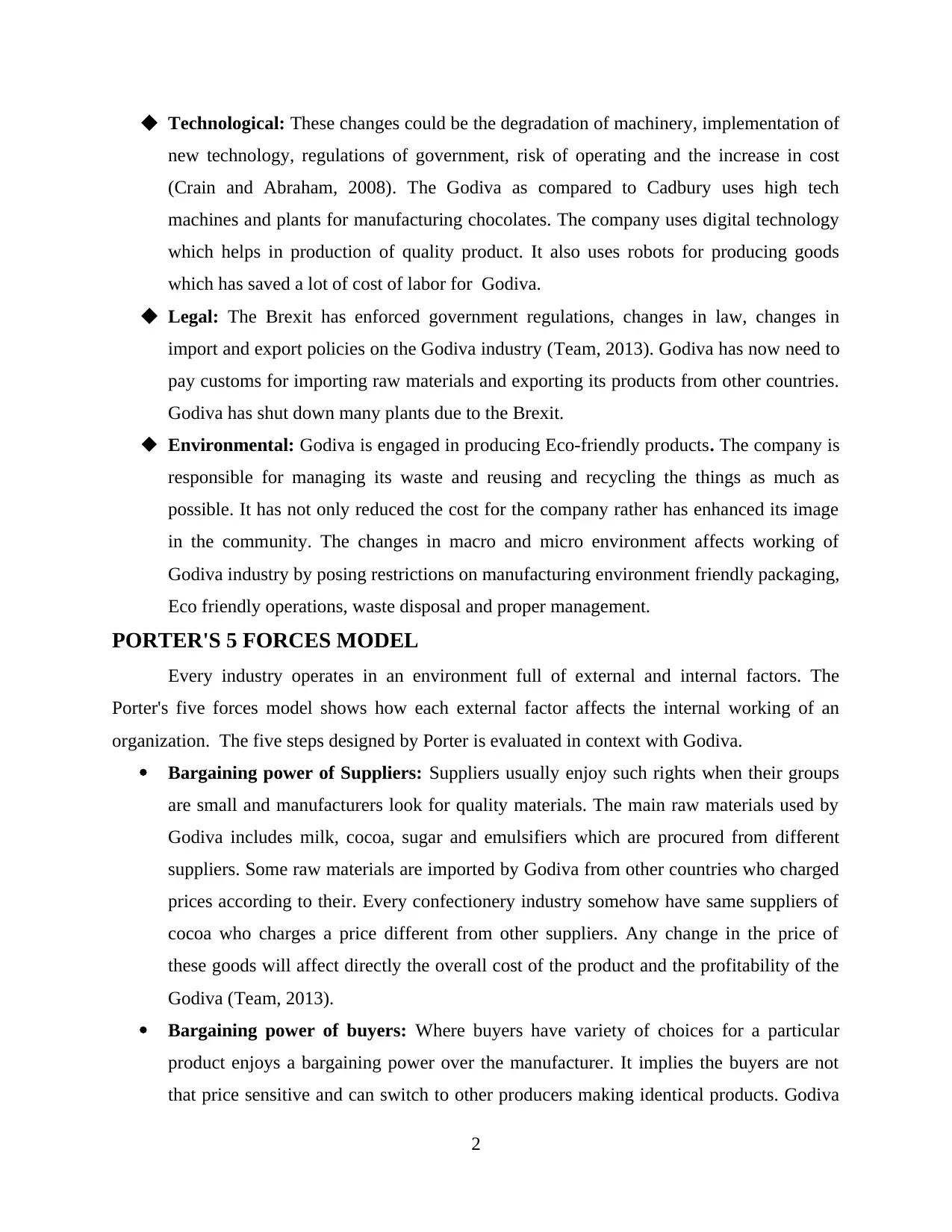
Technological: These changes could be the degradation of machinery, implementation of
new technology, regulations of government, risk of operating and the increase in cost
(Crain and Abraham, 2008). The Godiva as compared to Cadbury uses high tech
machines and plants for manufacturing chocolates. The company uses digital technology
which helps in production of quality product. It also uses robots for producing goods
which has saved a lot of cost of labor for Godiva.
Legal: The Brexit has enforced government regulations, changes in law, changes in
import and export policies on the Godiva industry (Team, 2013). Godiva has now need to
pay customs for importing raw materials and exporting its products from other countries.
Godiva has shut down many plants due to the Brexit.
Environmental: Godiva is engaged in producing Eco-friendly products. The company is
responsible for managing its waste and reusing and recycling the things as much as
possible. It has not only reduced the cost for the company rather has enhanced its image
in the community. The changes in macro and micro environment affects working of
Godiva industry by posing restrictions on manufacturing environment friendly packaging,
Eco friendly operations, waste disposal and proper management.
PORTER'S 5 FORCES MODEL
Every industry operates in an environment full of external and internal factors. The
Porter's five forces model shows how each external factor affects the internal working of an
organization. The five steps designed by Porter is evaluated in context with Godiva.
Bargaining power of Suppliers: Suppliers usually enjoy such rights when their groups
are small and manufacturers look for quality materials. The main raw materials used by
Godiva includes milk, cocoa, sugar and emulsifiers which are procured from different
suppliers. Some raw materials are imported by Godiva from other countries who charged
prices according to their. Every confectionery industry somehow have same suppliers of
cocoa who charges a price different from other suppliers. Any change in the price of
these goods will affect directly the overall cost of the product and the profitability of the
Godiva (Team, 2013).
Bargaining power of buyers: Where buyers have variety of choices for a particular
product enjoys a bargaining power over the manufacturer. It implies the buyers are not
that price sensitive and can switch to other producers making identical products. Godiva
2
new technology, regulations of government, risk of operating and the increase in cost
(Crain and Abraham, 2008). The Godiva as compared to Cadbury uses high tech
machines and plants for manufacturing chocolates. The company uses digital technology
which helps in production of quality product. It also uses robots for producing goods
which has saved a lot of cost of labor for Godiva.
Legal: The Brexit has enforced government regulations, changes in law, changes in
import and export policies on the Godiva industry (Team, 2013). Godiva has now need to
pay customs for importing raw materials and exporting its products from other countries.
Godiva has shut down many plants due to the Brexit.
Environmental: Godiva is engaged in producing Eco-friendly products. The company is
responsible for managing its waste and reusing and recycling the things as much as
possible. It has not only reduced the cost for the company rather has enhanced its image
in the community. The changes in macro and micro environment affects working of
Godiva industry by posing restrictions on manufacturing environment friendly packaging,
Eco friendly operations, waste disposal and proper management.
PORTER'S 5 FORCES MODEL
Every industry operates in an environment full of external and internal factors. The
Porter's five forces model shows how each external factor affects the internal working of an
organization. The five steps designed by Porter is evaluated in context with Godiva.
Bargaining power of Suppliers: Suppliers usually enjoy such rights when their groups
are small and manufacturers look for quality materials. The main raw materials used by
Godiva includes milk, cocoa, sugar and emulsifiers which are procured from different
suppliers. Some raw materials are imported by Godiva from other countries who charged
prices according to their. Every confectionery industry somehow have same suppliers of
cocoa who charges a price different from other suppliers. Any change in the price of
these goods will affect directly the overall cost of the product and the profitability of the
Godiva (Team, 2013).
Bargaining power of buyers: Where buyers have variety of choices for a particular
product enjoys a bargaining power over the manufacturer. It implies the buyers are not
that price sensitive and can switch to other producers making identical products. Godiva
2
Paraphrase This Document
Need a fresh take? Get an instant paraphrase of this document with our AI Paraphraser
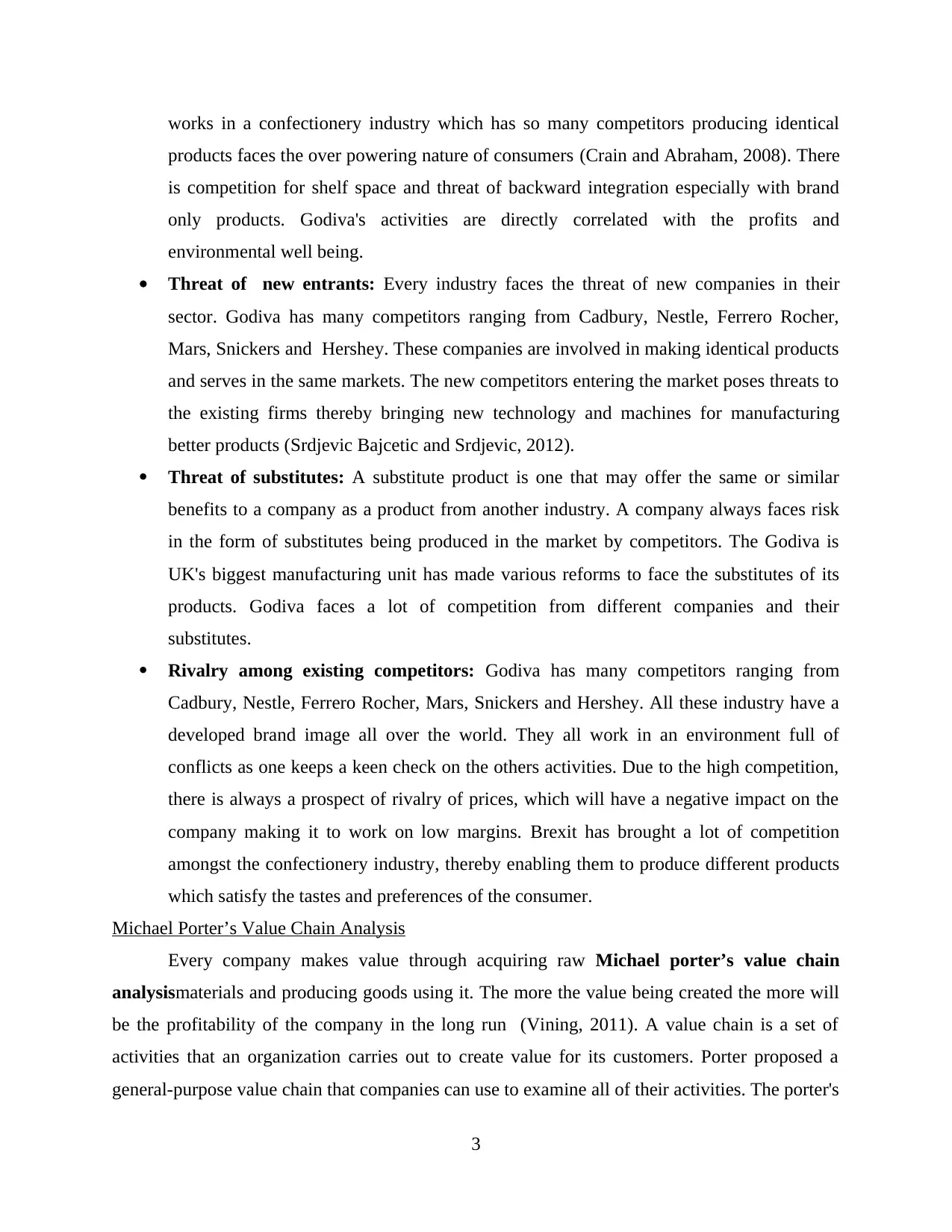
works in a confectionery industry which has so many competitors producing identical
products faces the over powering nature of consumers (Crain and Abraham, 2008). There
is competition for shelf space and threat of backward integration especially with brand
only products. Godiva's activities are directly correlated with the profits and
environmental well being.
Threat of new entrants: Every industry faces the threat of new companies in their
sector. Godiva has many competitors ranging from Cadbury, Nestle, Ferrero Rocher,
Mars, Snickers and Hershey. These companies are involved in making identical products
and serves in the same markets. The new competitors entering the market poses threats to
the existing firms thereby bringing new technology and machines for manufacturing
better products (Srdjevic Bajcetic and Srdjevic, 2012).
Threat of substitutes: A substitute product is one that may offer the same or similar
benefits to a company as a product from another industry. A company always faces risk
in the form of substitutes being produced in the market by competitors. The Godiva is
UK's biggest manufacturing unit has made various reforms to face the substitutes of its
products. Godiva faces a lot of competition from different companies and their
substitutes.
Rivalry among existing competitors: Godiva has many competitors ranging from
Cadbury, Nestle, Ferrero Rocher, Mars, Snickers and Hershey. All these industry have a
developed brand image all over the world. They all work in an environment full of
conflicts as one keeps a keen check on the others activities. Due to the high competition,
there is always a prospect of rivalry of prices, which will have a negative impact on the
company making it to work on low margins. Brexit has brought a lot of competition
amongst the confectionery industry, thereby enabling them to produce different products
which satisfy the tastes and preferences of the consumer.
Michael Porter’s Value Chain Analysis
Every company makes value through acquiring raw Michael porter’s value chain
analysismaterials and producing goods using it. The more the value being created the more will
be the profitability of the company in the long run (Vining, 2011). A value chain is a set of
activities that an organization carries out to create value for its customers. Porter proposed a
general-purpose value chain that companies can use to examine all of their activities. The porter's
3
products faces the over powering nature of consumers (Crain and Abraham, 2008). There
is competition for shelf space and threat of backward integration especially with brand
only products. Godiva's activities are directly correlated with the profits and
environmental well being.
Threat of new entrants: Every industry faces the threat of new companies in their
sector. Godiva has many competitors ranging from Cadbury, Nestle, Ferrero Rocher,
Mars, Snickers and Hershey. These companies are involved in making identical products
and serves in the same markets. The new competitors entering the market poses threats to
the existing firms thereby bringing new technology and machines for manufacturing
better products (Srdjevic Bajcetic and Srdjevic, 2012).
Threat of substitutes: A substitute product is one that may offer the same or similar
benefits to a company as a product from another industry. A company always faces risk
in the form of substitutes being produced in the market by competitors. The Godiva is
UK's biggest manufacturing unit has made various reforms to face the substitutes of its
products. Godiva faces a lot of competition from different companies and their
substitutes.
Rivalry among existing competitors: Godiva has many competitors ranging from
Cadbury, Nestle, Ferrero Rocher, Mars, Snickers and Hershey. All these industry have a
developed brand image all over the world. They all work in an environment full of
conflicts as one keeps a keen check on the others activities. Due to the high competition,
there is always a prospect of rivalry of prices, which will have a negative impact on the
company making it to work on low margins. Brexit has brought a lot of competition
amongst the confectionery industry, thereby enabling them to produce different products
which satisfy the tastes and preferences of the consumer.
Michael Porter’s Value Chain Analysis
Every company makes value through acquiring raw Michael porter’s value chain
analysismaterials and producing goods using it. The more the value being created the more will
be the profitability of the company in the long run (Vining, 2011). A value chain is a set of
activities that an organization carries out to create value for its customers. Porter proposed a
general-purpose value chain that companies can use to examine all of their activities. The porter's
3
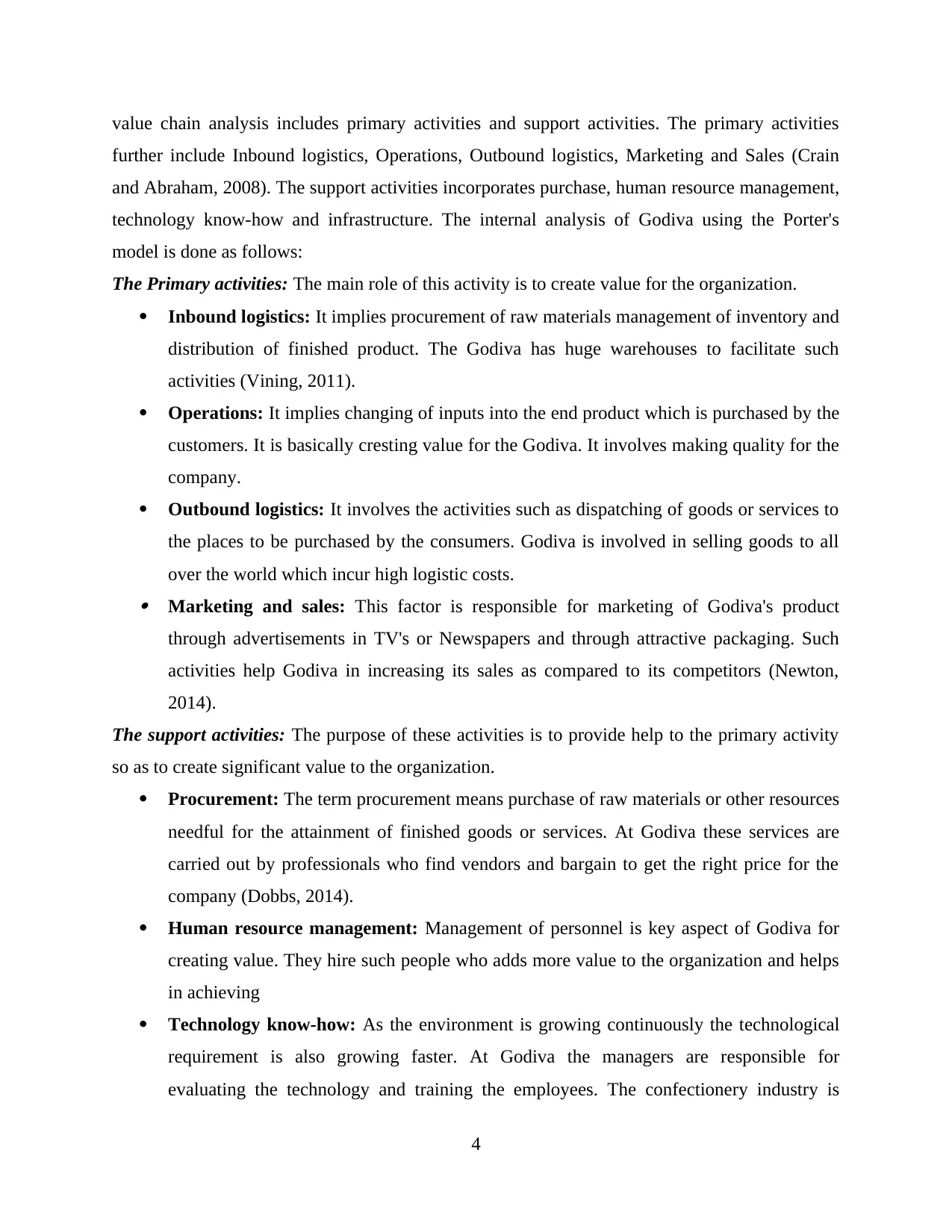
value chain analysis includes primary activities and support activities. The primary activities
further include Inbound logistics, Operations, Outbound logistics, Marketing and Sales (Crain
and Abraham, 2008). The support activities incorporates purchase, human resource management,
technology know-how and infrastructure. The internal analysis of Godiva using the Porter's
model is done as follows:
The Primary activities: The main role of this activity is to create value for the organization.
Inbound logistics: It implies procurement of raw materials management of inventory and
distribution of finished product. The Godiva has huge warehouses to facilitate such
activities (Vining, 2011).
Operations: It implies changing of inputs into the end product which is purchased by the
customers. It is basically cresting value for the Godiva. It involves making quality for the
company.
Outbound logistics: It involves the activities such as dispatching of goods or services to
the places to be purchased by the consumers. Godiva is involved in selling goods to all
over the world which incur high logistic costs. Marketing and sales: This factor is responsible for marketing of Godiva's product
through advertisements in TV's or Newspapers and through attractive packaging. Such
activities help Godiva in increasing its sales as compared to its competitors (Newton,
2014).
The support activities: The purpose of these activities is to provide help to the primary activity
so as to create significant value to the organization.
Procurement: The term procurement means purchase of raw materials or other resources
needful for the attainment of finished goods or services. At Godiva these services are
carried out by professionals who find vendors and bargain to get the right price for the
company (Dobbs, 2014).
Human resource management: Management of personnel is key aspect of Godiva for
creating value. They hire such people who adds more value to the organization and helps
in achieving
Technology know-how: As the environment is growing continuously the technological
requirement is also growing faster. At Godiva the managers are responsible for
evaluating the technology and training the employees. The confectionery industry is
4
further include Inbound logistics, Operations, Outbound logistics, Marketing and Sales (Crain
and Abraham, 2008). The support activities incorporates purchase, human resource management,
technology know-how and infrastructure. The internal analysis of Godiva using the Porter's
model is done as follows:
The Primary activities: The main role of this activity is to create value for the organization.
Inbound logistics: It implies procurement of raw materials management of inventory and
distribution of finished product. The Godiva has huge warehouses to facilitate such
activities (Vining, 2011).
Operations: It implies changing of inputs into the end product which is purchased by the
customers. It is basically cresting value for the Godiva. It involves making quality for the
company.
Outbound logistics: It involves the activities such as dispatching of goods or services to
the places to be purchased by the consumers. Godiva is involved in selling goods to all
over the world which incur high logistic costs. Marketing and sales: This factor is responsible for marketing of Godiva's product
through advertisements in TV's or Newspapers and through attractive packaging. Such
activities help Godiva in increasing its sales as compared to its competitors (Newton,
2014).
The support activities: The purpose of these activities is to provide help to the primary activity
so as to create significant value to the organization.
Procurement: The term procurement means purchase of raw materials or other resources
needful for the attainment of finished goods or services. At Godiva these services are
carried out by professionals who find vendors and bargain to get the right price for the
company (Dobbs, 2014).
Human resource management: Management of personnel is key aspect of Godiva for
creating value. They hire such people who adds more value to the organization and helps
in achieving
Technology know-how: As the environment is growing continuously the technological
requirement is also growing faster. At Godiva the managers are responsible for
evaluating the technology and training the employees. The confectionery industry is
4
⊘ This is a preview!⊘
Do you want full access?
Subscribe today to unlock all pages.

Trusted by 1+ million students worldwide
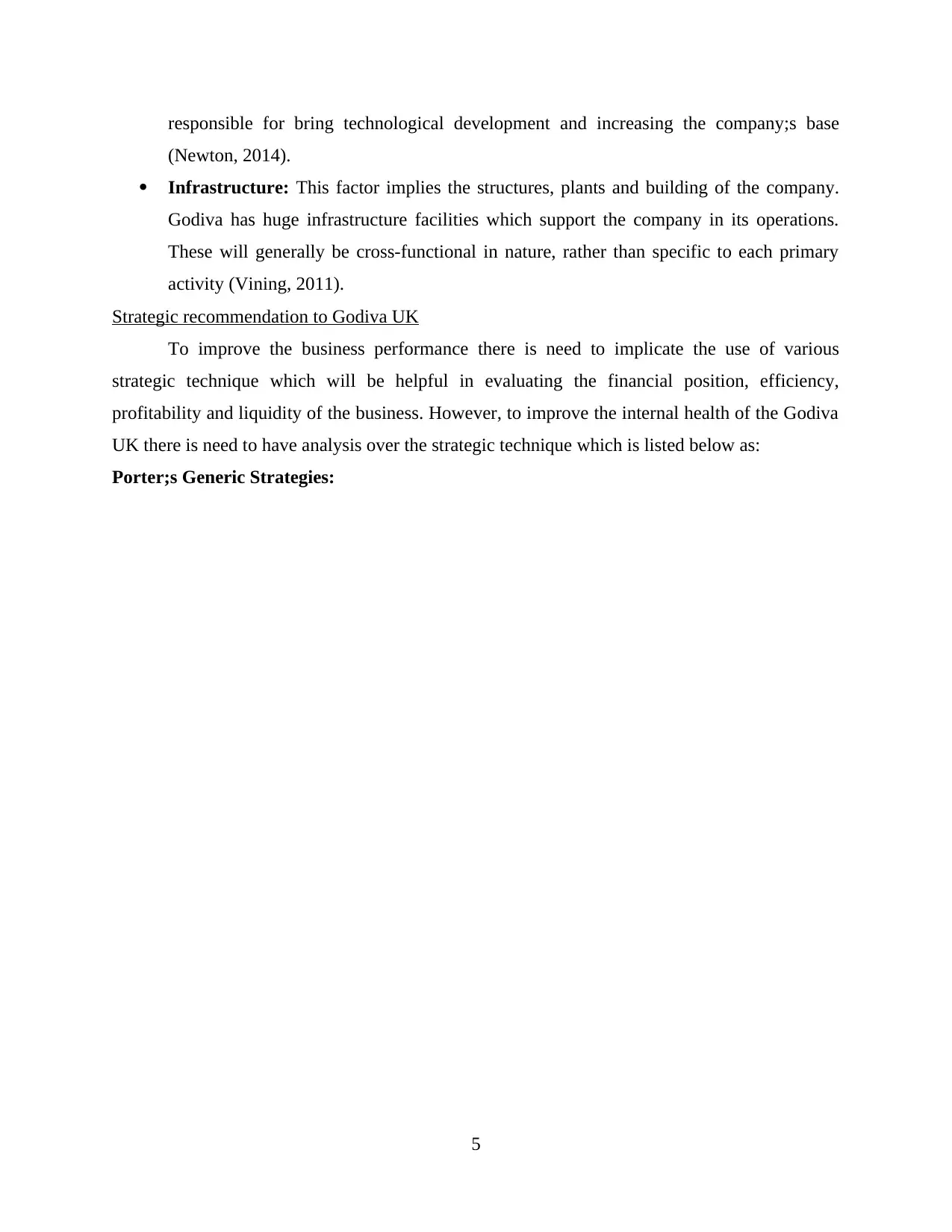
responsible for bring technological development and increasing the company;s base
(Newton, 2014).
Infrastructure: This factor implies the structures, plants and building of the company.
Godiva has huge infrastructure facilities which support the company in its operations.
These will generally be cross-functional in nature, rather than specific to each primary
activity (Vining, 2011).
Strategic recommendation to Godiva UK
To improve the business performance there is need to implicate the use of various
strategic technique which will be helpful in evaluating the financial position, efficiency,
profitability and liquidity of the business. However, to improve the internal health of the Godiva
UK there is need to have analysis over the strategic technique which is listed below as:
Porter;s Generic Strategies:
5
(Newton, 2014).
Infrastructure: This factor implies the structures, plants and building of the company.
Godiva has huge infrastructure facilities which support the company in its operations.
These will generally be cross-functional in nature, rather than specific to each primary
activity (Vining, 2011).
Strategic recommendation to Godiva UK
To improve the business performance there is need to implicate the use of various
strategic technique which will be helpful in evaluating the financial position, efficiency,
profitability and liquidity of the business. However, to improve the internal health of the Godiva
UK there is need to have analysis over the strategic technique which is listed below as:
Porter;s Generic Strategies:
5
Paraphrase This Document
Need a fresh take? Get an instant paraphrase of this document with our AI Paraphraser
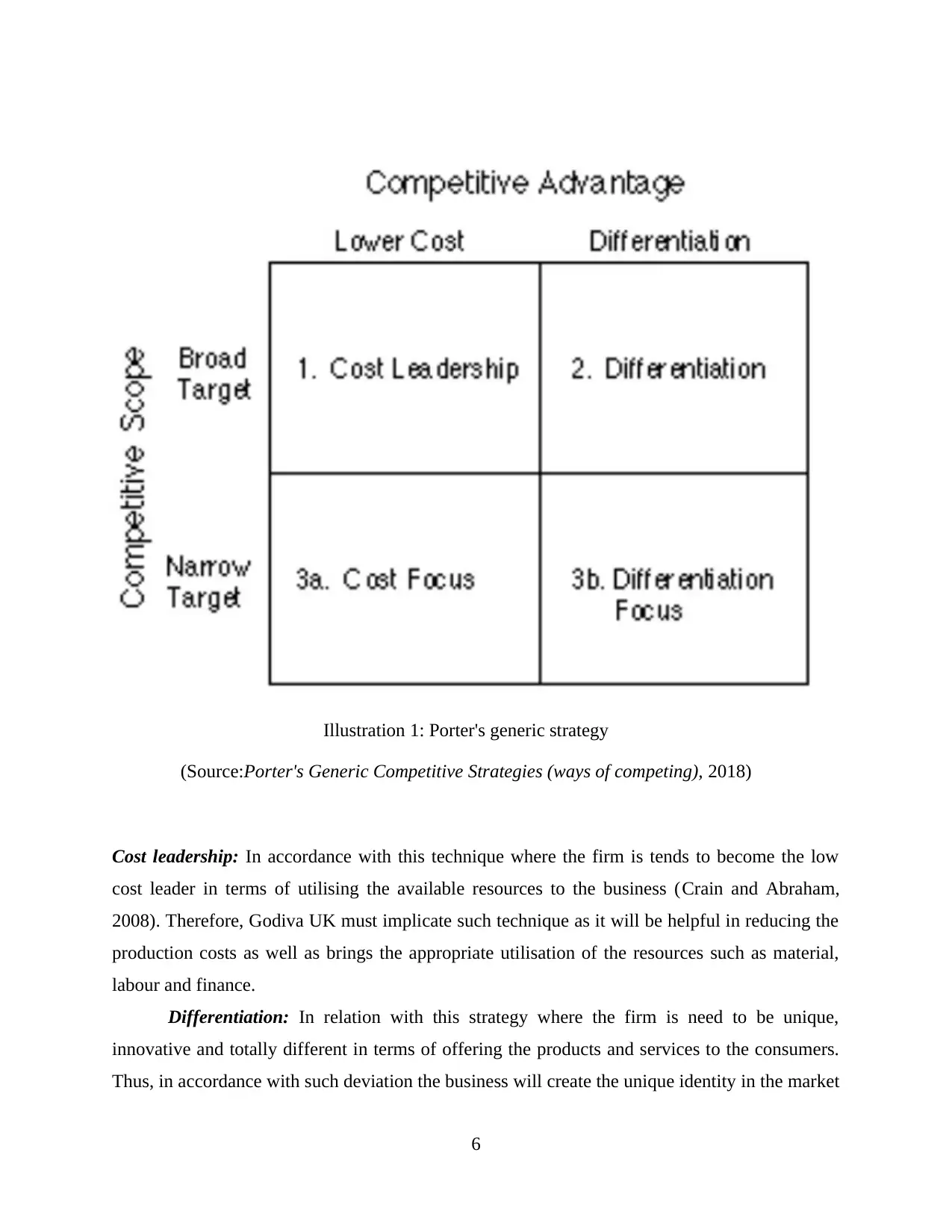
Illustration 1: Porter's generic strategy
(Source:Porter's Generic Competitive Strategies (ways of competing), 2018)
Cost leadership: In accordance with this technique where the firm is tends to become the low
cost leader in terms of utilising the available resources to the business (Crain and Abraham,
2008). Therefore, Godiva UK must implicate such technique as it will be helpful in reducing the
production costs as well as brings the appropriate utilisation of the resources such as material,
labour and finance.
Differentiation: In relation with this strategy where the firm is need to be unique,
innovative and totally different in terms of offering the products and services to the consumers.
Thus, in accordance with such deviation the business will create the unique identity in the market
6
(Source:Porter's Generic Competitive Strategies (ways of competing), 2018)
Cost leadership: In accordance with this technique where the firm is tends to become the low
cost leader in terms of utilising the available resources to the business (Crain and Abraham,
2008). Therefore, Godiva UK must implicate such technique as it will be helpful in reducing the
production costs as well as brings the appropriate utilisation of the resources such as material,
labour and finance.
Differentiation: In relation with this strategy where the firm is need to be unique,
innovative and totally different in terms of offering the products and services to the consumers.
Thus, in accordance with such deviation the business will create the unique identity in the market
6
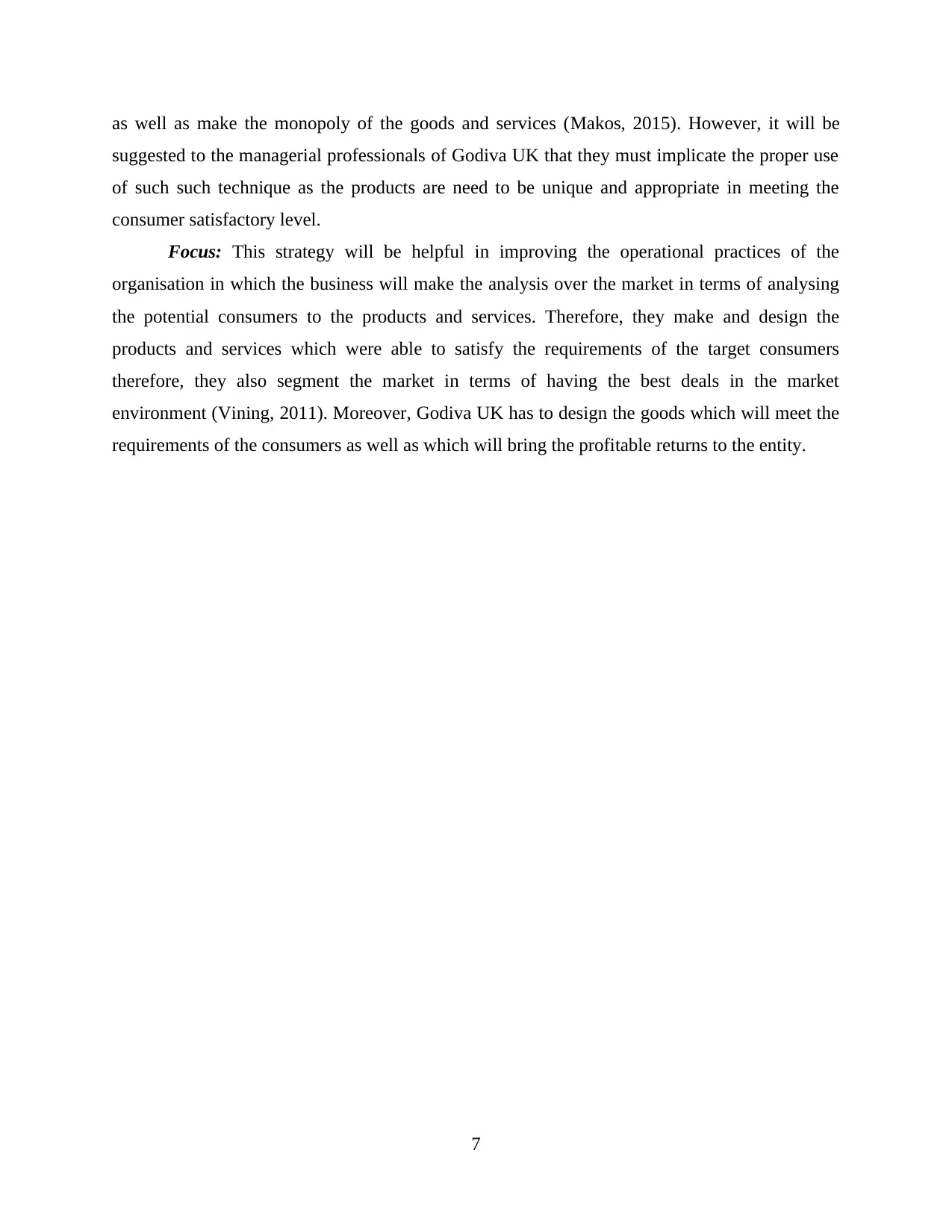
as well as make the monopoly of the goods and services (Makos, 2015). However, it will be
suggested to the managerial professionals of Godiva UK that they must implicate the proper use
of such such technique as the products are need to be unique and appropriate in meeting the
consumer satisfactory level.
Focus: This strategy will be helpful in improving the operational practices of the
organisation in which the business will make the analysis over the market in terms of analysing
the potential consumers to the products and services. Therefore, they make and design the
products and services which were able to satisfy the requirements of the target consumers
therefore, they also segment the market in terms of having the best deals in the market
environment (Vining, 2011). Moreover, Godiva UK has to design the goods which will meet the
requirements of the consumers as well as which will bring the profitable returns to the entity.
7
suggested to the managerial professionals of Godiva UK that they must implicate the proper use
of such such technique as the products are need to be unique and appropriate in meeting the
consumer satisfactory level.
Focus: This strategy will be helpful in improving the operational practices of the
organisation in which the business will make the analysis over the market in terms of analysing
the potential consumers to the products and services. Therefore, they make and design the
products and services which were able to satisfy the requirements of the target consumers
therefore, they also segment the market in terms of having the best deals in the market
environment (Vining, 2011). Moreover, Godiva UK has to design the goods which will meet the
requirements of the consumers as well as which will bring the profitable returns to the entity.
7
⊘ This is a preview!⊘
Do you want full access?
Subscribe today to unlock all pages.

Trusted by 1+ million students worldwide
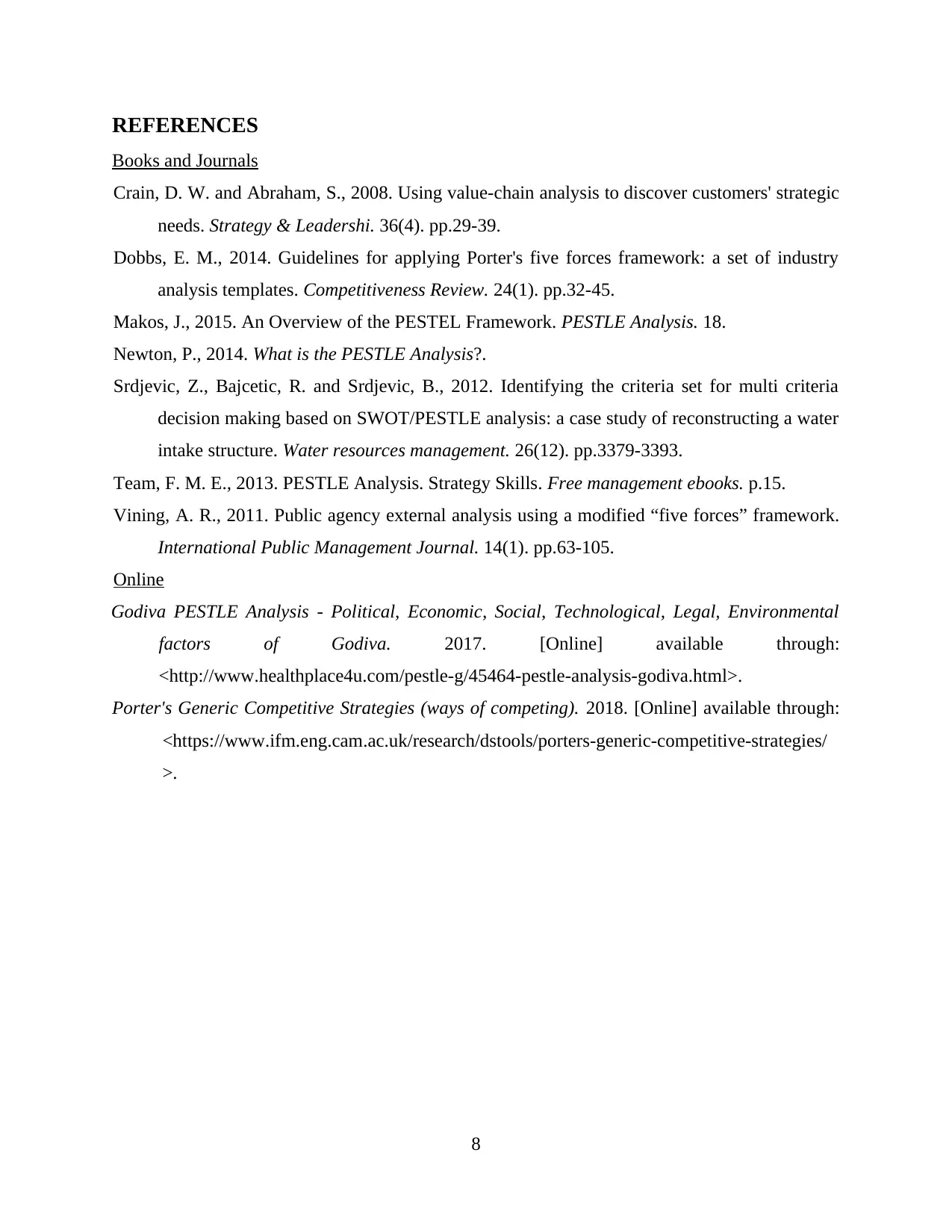
REFERENCES
Books and Journals
Crain, D. W. and Abraham, S., 2008. Using value-chain analysis to discover customers' strategic
needs. Strategy & Leadershi. 36(4). pp.29-39.
Dobbs, E. M., 2014. Guidelines for applying Porter's five forces framework: a set of industry
analysis templates. Competitiveness Review. 24(1). pp.32-45.
Makos, J., 2015. An Overview of the PESTEL Framework. PESTLE Analysis. 18.
Newton, P., 2014. What is the PESTLE Analysis?.
Srdjevic, Z., Bajcetic, R. and Srdjevic, B., 2012. Identifying the criteria set for multi criteria
decision making based on SWOT/PESTLE analysis: a case study of reconstructing a water
intake structure. Water resources management. 26(12). pp.3379-3393.
Team, F. M. E., 2013. PESTLE Analysis. Strategy Skills. Free management ebooks. p.15.
Vining, A. R., 2011. Public agency external analysis using a modified “five forces” framework.
International Public Management Journal. 14(1). pp.63-105.
Online
Godiva PESTLE Analysis - Political, Economic, Social, Technological, Legal, Environmental
factors of Godiva. 2017. [Online] available through:
<http://www.healthplace4u.com/pestle-g/45464-pestle-analysis-godiva.html>.
Porter's Generic Competitive Strategies (ways of competing). 2018. [Online] available through:
<https://www.ifm.eng.cam.ac.uk/research/dstools/porters-generic-competitive-strategies/
>.
8
Books and Journals
Crain, D. W. and Abraham, S., 2008. Using value-chain analysis to discover customers' strategic
needs. Strategy & Leadershi. 36(4). pp.29-39.
Dobbs, E. M., 2014. Guidelines for applying Porter's five forces framework: a set of industry
analysis templates. Competitiveness Review. 24(1). pp.32-45.
Makos, J., 2015. An Overview of the PESTEL Framework. PESTLE Analysis. 18.
Newton, P., 2014. What is the PESTLE Analysis?.
Srdjevic, Z., Bajcetic, R. and Srdjevic, B., 2012. Identifying the criteria set for multi criteria
decision making based on SWOT/PESTLE analysis: a case study of reconstructing a water
intake structure. Water resources management. 26(12). pp.3379-3393.
Team, F. M. E., 2013. PESTLE Analysis. Strategy Skills. Free management ebooks. p.15.
Vining, A. R., 2011. Public agency external analysis using a modified “five forces” framework.
International Public Management Journal. 14(1). pp.63-105.
Online
Godiva PESTLE Analysis - Political, Economic, Social, Technological, Legal, Environmental
factors of Godiva. 2017. [Online] available through:
<http://www.healthplace4u.com/pestle-g/45464-pestle-analysis-godiva.html>.
Porter's Generic Competitive Strategies (ways of competing). 2018. [Online] available through:
<https://www.ifm.eng.cam.ac.uk/research/dstools/porters-generic-competitive-strategies/
>.
8
Paraphrase This Document
Need a fresh take? Get an instant paraphrase of this document with our AI Paraphraser

9
1 out of 11
Related Documents
Your All-in-One AI-Powered Toolkit for Academic Success.
+13062052269
info@desklib.com
Available 24*7 on WhatsApp / Email
![[object Object]](/_next/static/media/star-bottom.7253800d.svg)
Unlock your academic potential
Copyright © 2020–2025 A2Z Services. All Rights Reserved. Developed and managed by ZUCOL.





